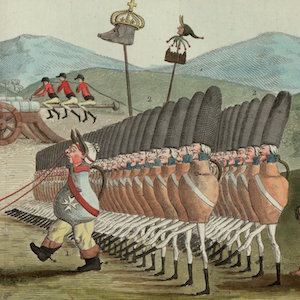Revolutions

Transportation of Voltaire to the French Panthéon, 8 July 1792
Although Voltaire’s contribution to the Revolution has been much debated, the revolutionaries themselves had absolutely no doubt of his significance. After 1789 he was much in vogue, in that his plays were often performed and other artists lionized him in various ways.

Arrest of Louis Capet at Varennes, June 22, 1791
This print shows an angry crowd of fervent revolutionaries breaking down doors to arrest the King.

Army of Jugs
This color drawing, produced in 1793 at the request of the Committee of Public Safety and then published as an engraving, caricatures the British army and its king, George III, as incompetent, who, despite fine uniforms, cannot defeat shoddily clad, yet energetic sans–culottes (on the left), who

Aristocratic Occupations
The second image, a color drawing by the popular English caricaturist James Gillray in 1805 during the Empire, takes a different view of the Directory, suggesting that it is a time of moral decadence and self–aggrandizement.

An Ordinary Guillotine
The guillotine was first introduced as a humane, efficient, and above all modern form of execution in April 1792; during the radical phase of the Republic, it would become the symbol of the Terror. This engraving suggests the guillotine is providing "good support for liberty."

An Emblematical View of the Constitutions of England and France
Similar to the two engravings of trees, this engraving contrasts English order with French anarchy. On the left, a lion (representing England) sits at the foot of a chiseled rock, part of which is labeled "Unanimity." A crown appears over the rock; a unicorn lies behind it.

Allegory of Truth
Female revolutionary figures stood for all kinds of qualities and virtues, in this case, "Truth." Women figures appeared so prominently in paintings and engravings because French nouns for the qualities and virtues were usually feminine (Truth = La Vérité).

Ah! Monsignor!
Not uncommonly, revolutionary prints invoked excretory humor directed toward those priests who would not swear allegiance to the Revolution. Revolutionaries eliminated on their enemies; the latter might also receive enemas.

Active Citizen/ Passive Citizen
This cartoon mocks the distinction between active and passive citizens. Many revolutionaries hated this difference, essentially dividing those with property from those without. The propertied (active) were the only ones who could participate in the political process.

Act of Justice
Here Robespierre’s death is depicted as divine retribution, as in a classical myth.